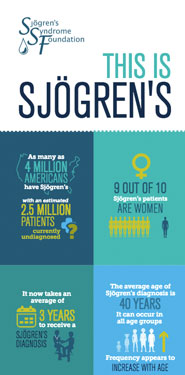 BETHESDA, Md.—For the overwhelming majority of patients living with Sjögren’s, an autoimmune disorder affecting more than four million Americans (90 percent of whom are women), every day is a challenge in coping with the disease, limiting their ability to function at home and in the workplace. These were the results of a recent survey conducted by Harris Poll on behalf of the Sjögren’s Syndrome Foundation (SSF), the only non-profit organization focused on increasing research, education and awareness for Sjögren’s.
BETHESDA, Md.—For the overwhelming majority of patients living with Sjögren’s, an autoimmune disorder affecting more than four million Americans (90 percent of whom are women), every day is a challenge in coping with the disease, limiting their ability to function at home and in the workplace. These were the results of a recent survey conducted by Harris Poll on behalf of the Sjögren’s Syndrome Foundation (SSF), the only non-profit organization focused on increasing research, education and awareness for Sjögren’s.
Nearly 3,000 patients (96 percent women), aged 18+ years in the U.S. and diagnosed with Sjögren’s, shared their experiences with the disease and its physical and emotional effects on their lives in the nationwide Living with Sjögren’s survey, which was conducted between May 11 and July 11, 2016.
“Sjögren’s is a systemic autoimmune disease that affects the entire body,” explains SSF CEO Steven Taylor. “Approximately 1 percent of the U.S. population, mostly adult women, are affected. This is similar to the number of women living with breast cancer.
“Along with symptoms of extensive dryness, other serious complications such as profound fatigue, chronic pain, organ dysfunction, neuropathies and lymphomas can greatly impair a patient’s ability to perform everyday tasks. This research brings to the forefront the significant quality of life challenges faced by Sjögren’s patients in trying to live with this often-debilitating disease,” Taylor said.
Approximately half of the patients described dry eyes (54 percent), fatigue (54 percent, and dry mouth (50 percent), the three most commonly reported symptoms of Sjögren’s, as having a major impact on their lives in the last year.
“If you break a bone and wear a cast others can see your injury and understand your limitations,” said Taylor. “But with Sjögren’s, your symptoms are not clearly visible so not only do you have to put up with challenging, often painful, and sometimes debilitating conditions every day, but you may face disbelief from family, friends, co-workers and even doctors, who don’t understand what’s wrong with you.”
According to the SSF, an estimated 2.5 million patients are currently undiagnosed and it takes an average of three years to receive a correct diagnosis. “Sjögren’s is often undiagnosed or misdiagnosed because disease symptoms frequently overlap or mimic those of menopause, allergies or medical conditions such as lupus, rheumatoid arthritis, fibromyalgia, and chronic fatigue syndrome,” according to Nancy Carteron, MD, FACR, clinical associate professor of medicine at the University of California San Francisco and chair of SSF’s Medical and Scientific Advisory Board.
Rheumatologists have primary responsibility for managing Sjögren’s and patients are also seen and treated by ophthalmologists, optometrists, dentists and other specialists depending on their complications. According to the survey, Sjögren's patients, on average, said they see almost five different health care professionals (4.6 mean) at least once a year to help manage their disease. Until 2016, no standard of care existed for the management of Sjögren’s. The SSF, with the assistance of hundreds of physicians and dentists, developed and published clinical practice guidelines to standardize patient care and give doctors a roadmap of how to treat and manage their patients with Sjögrens.
Currently, there is no cure for Sjögren’s but there are treatments that may improve various symptoms and prevent complications. On average, Sjögren’s patients said they use nearly nine medications and treatments (8.8 mean) to help with their Sjögren’s symptoms.
ECPS can learn more about this disease from this helpful INFOGRAPHIC, issued earlier this month. April 2017 marks the 19th annual Sjögren’s Awareness Month.
